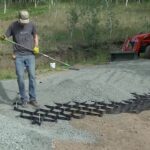Are you looking to strengthen the foundation of your house? Sure, it can be intimidating – especially if you’re a novice when it comes to construction work. But once you know the different elements that need attention before taking on this task, redoing the foundation of your house doesn’t have to feel overwhelming. To help take some stress out of the process, we’ve gathered several tips to bear in mind while tackling this hefty project. Read through our guide for an overview of what should go into ensuring that restructuring and renovation go smoothly and get yourself ready for a successful upgrade!

Research the type of foundation your home has
When it comes to owning a home, the foundation is one of the most important aspects to consider. A strong foundation can make all the difference in how households up over time. So it’s worth knowing what type of foundation your home has and the potential costs associated with it. There are several types of foundations including basement, slab-on-grade, crawlspace, and pier and beam. Some may be more expensive to install or repair than others. For example, a basement foundation can be costly due to excavation and waterproofing needs. On the other hand, a slab-on-grade foundation may be more affordable yet may not provide as much storage space as a basement. Understanding the type of foundation your home has and the costs associated with it can help you plan for maintenance and repairs in the future.
Consider restumping
Restumping, also known as reblocking, involves replacing old timber stumps on a house with new, more durable stumps. If you live in Australia, restumping is a common practice when redoing the foundation of your house. If you’re considering undertaking this project and you live in Victoria’s capital, securing a high-quality restumping service in Melbourne is a crucial step in ensuring a solid, long-lasting foundation for your home. It’s a critical aspect to consider if your home foundation is built on stumps, especially if they are beginning to show signs of rot or structural wear. Over time, the stumps may deteriorate due to soil movement, environmental conditions, or termite damage, which could compromise the stability of your house. Restumping can address these issues by stabilizing your home and extending the longevity of its structure. However, keep in mind that this process can be quite costly and time-consuming, and usually requires professional expertise to ensure that it’s done correctly and safely.
Be mindful of the weather and season when planning to renovate
The weather and season can significantly impact your foundation redo project. Wet conditions, for instance, can make the soil unstable and hazardous for work. Similarly, freezing temperatures can also cause the ground to harden, making excavation more challenging. Therefore, it’s advisable to plan this project for a time when the weather is generally dry and temperate. Typically, late spring and early fall are considered ideal seasons for such undertakings. This is because the ground is usually dry and stable, making it safer and easier to work with.
Get estimates from several different contractors
Before diving headfirst into the project, it’s essential to get several estimates from different contractors. This not only helps you to understand the expected costs involved but also gives you an opportunity to gauge the experience and reliability of different professionals. While it might be tempting to go with the cheapest option, remember that quality and expertise should always be a top priority. After all, the foundation of your home is integral to its overall stability and longevity. Ask for a detailed breakdown of the costs and ensure that you are comparing like for like. This practice will help you make an informed decision and prevent unforeseen expenses down the line.
Familiarize yourself with building regulations, codes, and standards in your area
Building a foundation involves more than just digging and pouring concrete. It’s also necessary to comply with local building codes, regulations, and standards. These guidelines are designed to ensure the safety, quality, and durability of your home. They cover everything from soil conditions, depth of footings, and the type of concrete mix used, to waterproofing, insulation, and seismic considerations. Ignorance of these rules can lead to serious legal consequences and can even endanger the structural integrity of your house. Therefore, before embarking on the project, familiarize yourself with these regulations. If you’re unsure, consult with a local building code official or a professional contractor to ensure that your project complies with all relevant requirements.
Make sure all materials used are high-quality for a long-lasting result
The quality of materials used in the construction of your foundation is paramount to its longevity and durability. Using substandard materials may result in cracks, leaks, or even structural failure over time. It’s important to select high-grade concrete mix, steel reinforcement bars, and waterproofing products. Additionally, ensure the aggregates, such as sand and gravel used in the concrete mix, are clean and free from impurities that could weaken the foundation. Quality doesn’t necessarily mean expensive, but it does require research and sound judgment. It’s an investment in the future stability of your home, and compromising on quality could lead to costly repairs down the line.
Spend time ensuring proper drainage systems
A proper drainage system is crucial to maintain the integrity of your home’s foundation. This system manages water flow around your property, preventing buildup that could seep into the foundation, causing damaging erosion or cracks over time. Ideally, the landscape should slope away from your home to naturally direct rainfall away from the foundation. Additionally, installing gutters and downspouts can help channel roof runoff away from the base of your house. If water issues persist, consider investing in a French drain or a sump pump. These measures can significantly reduce the risk of water damage to your foundation, thus protecting your home in the long run.

Redoing the foundation of your house is no small task, but it’s certainly a manageable one when approached with careful planning and due diligence. From understanding your home’s foundation type to considering restumping and taking into account weather conditions, there are several factors to contemplate before embarking on this project. It’s crucial to get estimates from multiple contractors, ensure compliance with local building codes, use high-quality materials, and establish a proper drainage system. With these precautions in place, you can look forward to a solid, long-lasting foundation that grants your home the stability and durability it needs to withstand the test of time.
















